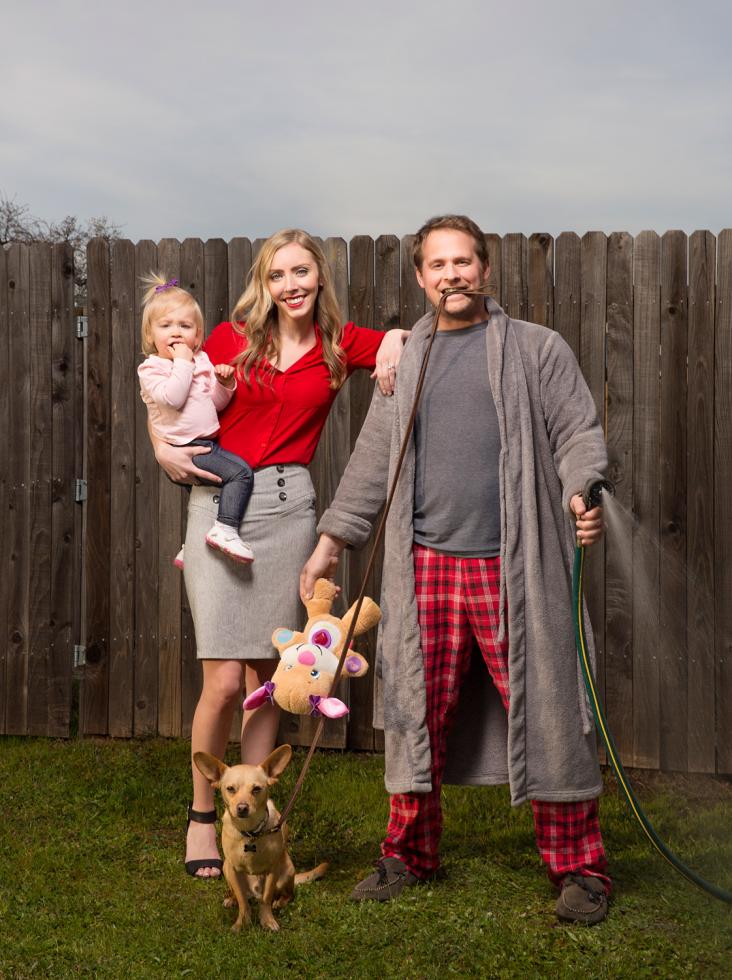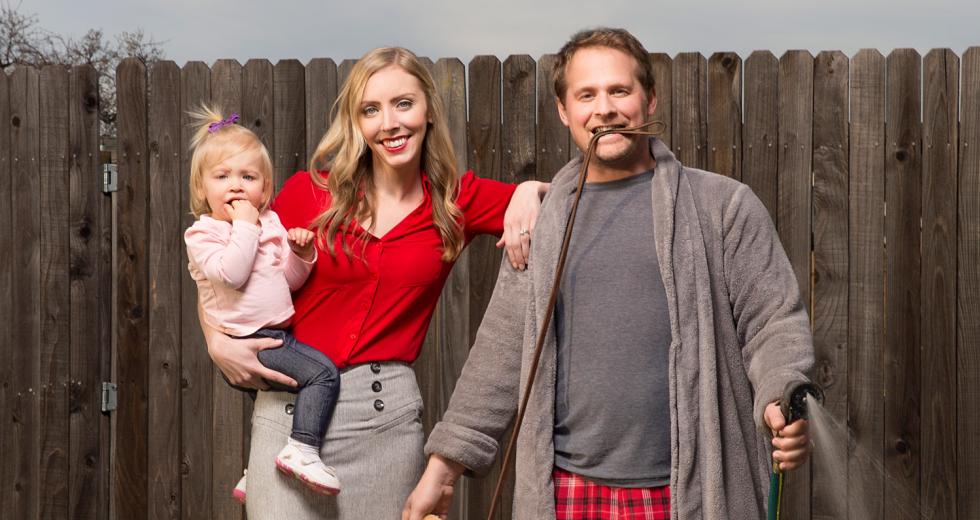Until the summer of 2015, Aaron and Jamie Duke, 37 and 27, were happy to be the picture of the urban millennial couple traveling light. They had an 800-square-foot apartment at Capitol Towers at 7th and N streets. That was less than three blocks from Jamie’s job at the State Board of Equalization, and they could walk to bars and restaurants. They had cars but would go days without driving. Most of their friends lived downtown too.
But then their daughter was born. They got a second dog. And pretty soon they were down to one aisle through their living room. Suddenly more room and a yard were pulling ahead of Jamie’s 5-minute walk to work on their priority list.
The Dukes were priced out of East Sacramento, where they first looked — $600,000 or so for the space they wanted. So instead, last June, they closed on a house in Roseville — 2,050 square feet, four bedrooms, three baths, and a garage and pool on a quarter-acre — for just over $400,000. Many of their peers are still downtown, but summer barbecues at the pool entice their friends into weekend party-commuting to their house. Now Jamie has a 1-hour drive in traffic to work. (Aaron manages the U.S. branch of a European company and was able to relocate their office to Roseville.) But they’re happy they made the move.
Millennials — people born between the early ‘80s and mid-’90s — have a deserved reputation for wanting to live in cities, own nothing, live in a tiny footprint, and bike and walk everywhere. But that track record may be situational. Now that they’re older and starting to have kids, the economics of schools and space are driving many of them to the suburbs, just as it did their parents.
The Apple Doesn’t Fall Far
Reports of millennials’ real estate behavior have largely focused on how different they are from their parents. A 2014 Nielsen report noted their heavy concentration within city limits in places like San Francisco, Los Angeles and San Diego. Others have focused on their low homeownership rates.
Census data shows that nearly twice as many people ages 20 to 34 moved from cities to suburbs between 2015 and 2016 as did the opposite.
But recent data show that picture changing as they age. In a January 2016 survey by online housing database Zillow, of more than 10,000 households, nine out of 10 millennials said they want to buy a home sometime, and two-thirds expect to do so within the next five years. In 2015, a slight majority of millennial home buyers bought in the suburbs, according to a National Association of Realtors report released last March. Only 17 percent bought in an urban area, down from 21 percent the previous year. In a 2015 National Association of Home Builders survey of about 1,500 millennials, two of every three said they want to live in the suburbs — only one of four said they want to live in cities.
And Census data shows that nearly twice as many people ages 20 to 34 moved from cities to suburbs between 2015 and 2016 as did the opposite.
In large part, millennials have stayed downtown because they’re delaying marriage and children longer than any generation before them. An analysis by polling firm Gallup last May found that just over a quarter of millennials were married in 2014, compared with more than a third of gen-Xer’s and almost half of baby boomers when they were the same age. And the average age of mothers at their child’s first birth continues to climb, going from 24.9 years in 2000 to 26.3 in 2014. But millennials still intend to have kids — in a 2013 Gallup poll, almost nine of 10 of those between ages 18 and 40 said they intended to have children someday.
Related: Back and Forward: Erin Stumpf on Residential Real Estate
That means more of them will be buying homes and looking to the suburbs, both because of space and school systems. Of millennial buyers in the National Association of Realtors survey, more than one in three said that the quality of schools was a factor influencing their buying decision, higher than any group other than gen-X’ers “You have a kid, you start thinking of schools,” says Aaron Duke. At this point, most of their friends don’t have children and so are still downtown. “But the ones who have families live out here,” he adds.
For the Dukes, that meant Roseville was perfect — a few years from now, they’ll be able to walk their daughter to the well-regarded Heritage Oak public school a few blocks away. “They’re mostly not doing anything so different from what other generations have done,” real estate agent Erin Stumpf of Dunnigan Realtors says of the millennial buyers with whom she’s worked.
It’s the Economics, Stupid
What may be different about millennials is that they’d stay downtown if they could afford to. Rosanna Garcia of Garcia Realty, a Sacramento Association of Realtors director, has worked with a lot of millennial buyers. She says that in her experience, if soon-to-be millennial parents can spend the premium for the space and schools they need, they’d rather stay near the central city. “Everybody wants to live near the action, but can you afford it?” she says. “For the majority of the population, cost is a factor. But you have some of these young people making really good money who are able to do it.”
Suzie Robertson Changus, 39 (a young gen-Xer) and her husband Jonathan Changus, 35, are one such couple. After owning a 70-year-old house in the Arden area, they moved to The Mill at Broadway last June, tired of the constant attention that an old house required. But their school situation is a key reason they can move downtown — they can afford to send their 7-year-old son to a private school in Arden, and they’re more comfortable living in a smaller footprint than some families — their new home has 1,450 square feet, about the same space they had in Arden.
To keep smaller families like the Changus’, Sacramento could use more of those modest-sized homes, says Bernadette Austin of the UC Davis Center for Regional Change. Developers find it easier to turn a profit on high-density units downtown where land costs are more expensive, or on bigger homes in the outer ring where land costs are low. It’s tougher to turn a profit on that “missing middle,” says Austin, referring to two- to three-bedroom, one- to two-bath homes with 1,000 to 1,500 square feet.
Jamie and Aaron Duke left downtown Sacramento and moved to
Roseville after the birth of their daughter.

A stronger job market would give developers confidence to invest in building them, says Darrell Teat, president of the Nehemiah Companies — which buys, renovates and resells distressed homes to low- and moderate-income first-time buyers and veterans. “There’s not a lot of inventory in the city, especially when it comes to three-bedroom, two-bath homes,” he says.
More homes like those probably wouldn’t help bigger families — the cost of living in the city would still push them to the suburbs. A 2016 survey of owners and renters by the California Association of Realtors found that of the millennials who planned to move, about 40 percent planned to do so for a lower cost of living or lower home prices, and another 7 percent for a better school system.
That was true for Becky Bastian, 32, and her husband Jesse Bastian, 36. They wanted to stay in their home on 25th Street in Midtown Sacramento. They had great neighbors, and she had less than a 15-minute bike ride to work as a nurse in the UC Davis Health System. But they had a new baby last year, and already had a toddler and a large dog. They planned for the move — over the course of two years, she estimates they looked at 200 houses. But homes in East Sacramento and Midtown with even a suggestion of a yard and the square footage they wanted — at least 2,000 square feet and .19 acre — cost at least $800,000, she says.
They ended up buying a 2,500-square-foot four-bedroom, 2.5-bath house on a half-acre in Fair Oaks for $625,000. She’ll now be sitting in her car half an hour a day instead of enjoying the breeze on her bike ride. “The commute to work is going to be awful, but we’re still excited,” she says of their move last December.
Making Suburbs More Like Cities
There are good reasons that many millennial families would rather stay in the city if they had the money to afford the space and a good school system — the active, car-free lifestyle still suits many of them. A 2015 National Association of Realtors survey, for example, found that those age 18 to 34 showed a much stronger preference than older generations for bikeable and walkable communities with good public transportation.
A few suburbs are accommodating those wishes by remaking themselves, says Stumpf. These new developments focus on more attractive public spaces — and fewer plus-sized lots and cul-de-sac mazes accessible only by car. She points to Capital Village, a master-planned community in Rancho Cordova. Developer Beazer Homes USA launched it in 2005 as a mixed-use neighborhood. Its layout is relatively dense, at nine to 15 units per acre. Its most popular model is a multi-hued attached rowhouse in a style Beazer calls “fusion.” The neighborhood includes nine acres of open space, trails and parks, an outdoor amphitheater for summer performances, and a town center with shops and retail. The development is connected by sidewalks and bike lanes to big employers like VSP Vision Care, Dignity Health and Kaiser Permanente — all within a 20-minute walk.
“We wanted to create a village and town center that’s unique in Rancho Cordova,” says Beazer’s Kaitlin Coghlin. About a third of the 440 units were sold to buyers under age 36, she says.
Marie Lavana, a 35-year-old account executive, has a three-bedroom, 2.5-bath home in Capital Village. Her house is a half-mile from her job, and she was attracted by the development’s parks, retail and restaurants in walking distance. “It marries urban living with suburbia,” she says. Beazer says the venture has been so successful that they’re building a second Capital Village of 300 lots next to the original, called Capital Village 2. In the new development, 60 percent of the homes are already sold, though it’s still a year from completion.
Another new neighborhood in that style is the Cannery, a mixed-use development of about 500 residences on about 100 acres on the site of the old Hunt-Wesson tomato processing plant in Davis. The developer, the New Home Company, did focus groups and learned that people wanted a neighborhood, not a traditional suburb — the ability to walk and bike to stores, good public transportation and shared neighborhood facilities.
So the Cannery has a community center with a pool and a shared kitchen for events, outdoor fireplaces, several parks and a dog park, and it’s skirted by a bike and walking path. Once finished, it will also have a mixed-use area with shops and retail. About 133 families already live there, and 172 lots have sold since it opened last August, says New Home northern California president Kevin Carson. “I see more suburbs trying to appeal to that green, walkable streetscape,” Stumpf says. “It’s kind of a hybrid lifestyle.”
That’s part of why older suburbs like Fair Oaks and Roseville are focusing on their downtown cores. Becky Bastian appreciates what Fair Oaks is starting to do — a microbrewery just opened, and she likes the area’s bike paths.
But she and her husband haven’t given up on Sacramento. They’re keeping their house in Midtown and renting it out. She says someday, when their kids have left, they just might be back.



